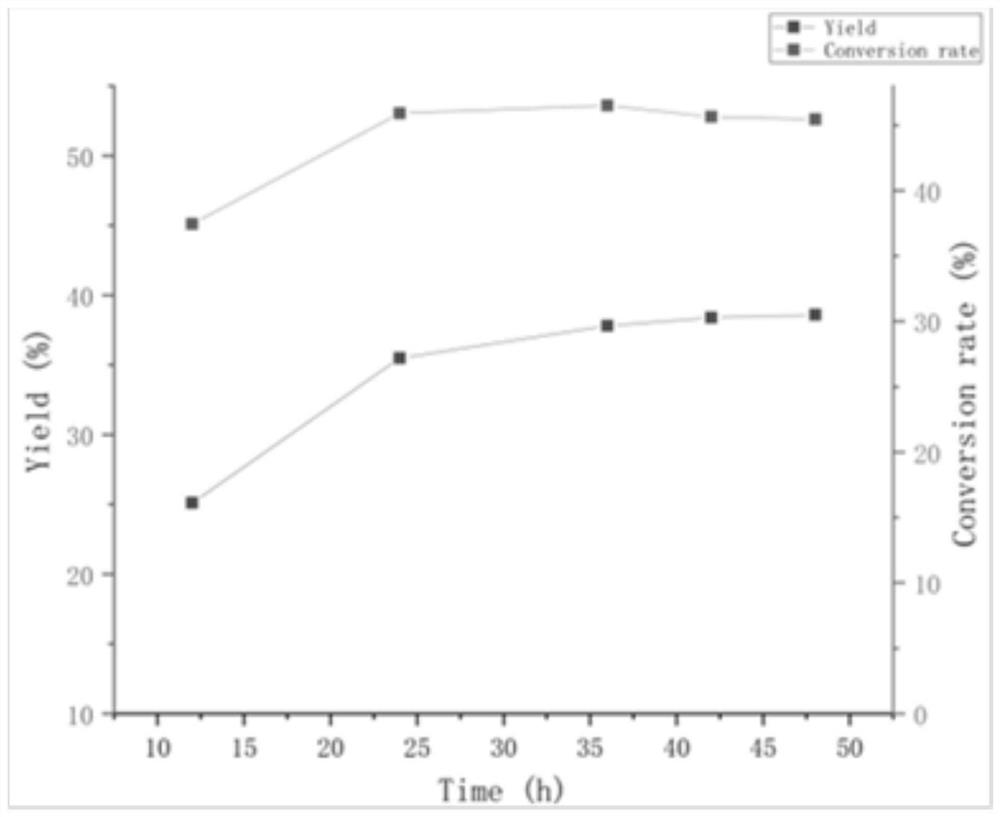Saccharomyces sp. HF-21 and method for preparing D-pantoic acid lactone through biphasic catalysis of Saccharomyces sp. HF-21
A technology of pantolactone and yeast strain, which is applied in the field of yeast strain HF-21 and its biphasic catalysis to prepare D-pantolactone, which can solve the problems of limited enzyme activity, low resolution efficiency, and chemical resolution. The problem of high reagent cost can be avoided, and the effect of avoiding inactivation and reducing the spontaneous hydrolysis rate of the substrate can be achieved.
- Summary
- Abstract
- Description
- Claims
- Application Information
AI Technical Summary
Problems solved by technology
Method used
Image
Examples
Embodiment 1
[0027] Example 1: A yeast strain HF-21 and its method for preparing D-pantolactone by biphasic catalysis
[0028] (1) Screening yeast strains with high activity keto-pantolactone reductase
[0029] Several yeasts were isolated from the soil, including Saccharomyces cerevisiae, Pichia pastoris and Candida ruberens, etc., and the strains were obtained through primary screening and secondary screening to verify the ability of ketopantoacidolactone catalytic effect.
[0030] Separation and purification of bacteria:
[0031] Select 1g of soil sample, add 9ml of sterile saline, vortex for 10min to mix thoroughly, take 10 -3 、10 -4 、10 -5 、10 -6 Spread 4 different dilutions on YPD solid plate medium (glucose 10g, soybean peptone 5g, yeast extract 15g, agar 20g, add deionized water to 1000ml, natural pH), and make 3 parallels for each dilution , and cultivated in a constant temperature incubator at 28°C for 2 days; then pick out a single colony with typical yeast colony charact...
Embodiment 2
[0069] The yeast strain is the original strain obtained from the soil of an orchard in Bozhou City, Anhui Province. After preliminary morphological observation, it conforms to the basic characteristics of yeast. A yeast strain HF21 with high production of ketopantolactone hydrolase was obtained by mutagenesis.
[0070] Original strain passed N + After ion implantation mutagenesis treatment, 100 strains of single colonies were selected for preliminary screening. Firstly, bacterial cells were prepared by shaking flask fermentation, and the bacterial cells were used to carry out the experiment of catalyzing keto-pantolactone, and 14 strains were screened with the yield of product (D-pantolactone)>10%. The 14 strains that were initially screened were collected by centrifugation after shaken flask fermentation, added to the catalytic reaction system, and catalyzed for 48 hours. The collected reaction solution was extracted with ethyl acetate to separate the product, and the fracti...
Embodiment 3
[0074] (1) Preparation and cultivation of slant bacteria: glucose 10g, peptone 10g, yeast extract 5g, agar 20g, add deionized water to 1000mL, natural pH. Take 30×200mm glass test tubes, each containing 20mL culture medium, sterilize at 121°C for 20min, cool to 50-60°C and place on an inclined plane. The slant inoculation loop was inoculated with yeast HF21 cells and cultured at 28±2°C.
[0075] (2) Seed medium formula: 2% glucose, 2% peptone, 1% yeast extract, 25mL in 250mL triangular flask, sterilized at 121°C for 20min. The inoculation shovel was used to inoculate the bacteria grown on the slope above, the culture temperature was 30±1° C., 200 rpm, and the shaker was shaken for 24-26 hours to obtain the seed solution.
[0076] (3) Fermentation medium formula: 2% glucose, 1% yeast powder, 0.15% potassium dihydrogen phosphate, the liquid volume in the shaker flask is 250 mL in a Erlenmeyer flask, and sterilized at 121° C. for 20 min. The seed solution was inoculated with an...
PUM
 Login to View More
Login to View More Abstract
Description
Claims
Application Information
 Login to View More
Login to View More - R&D
- Intellectual Property
- Life Sciences
- Materials
- Tech Scout
- Unparalleled Data Quality
- Higher Quality Content
- 60% Fewer Hallucinations
Browse by: Latest US Patents, China's latest patents, Technical Efficacy Thesaurus, Application Domain, Technology Topic, Popular Technical Reports.
© 2025 PatSnap. All rights reserved.Legal|Privacy policy|Modern Slavery Act Transparency Statement|Sitemap|About US| Contact US: help@patsnap.com



